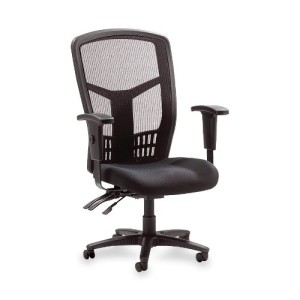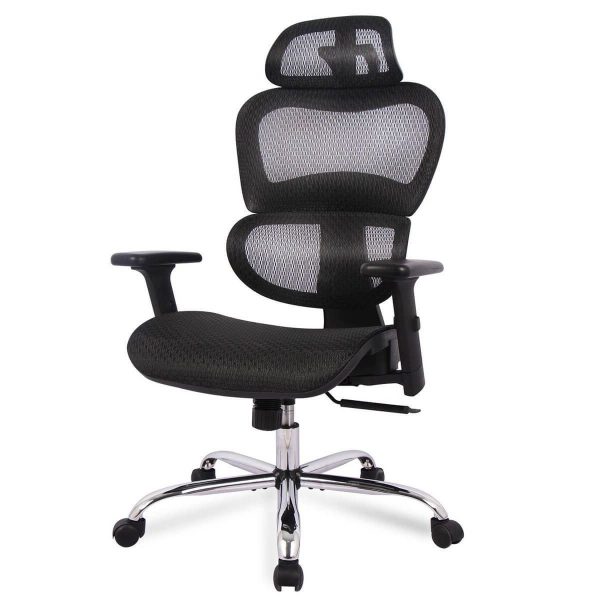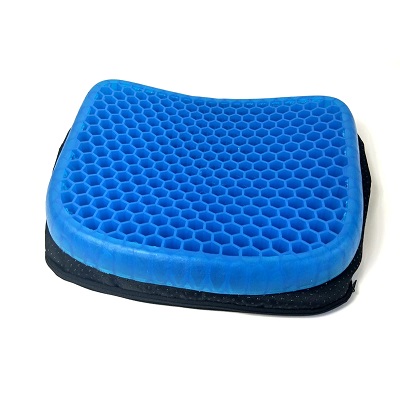
Sitting in your affordable ergonomic chair for long hours can cause lower back pain or worsen your existing sciatica problem.
That is because, sitting for long periods of time increases stress and tension in the arms, back, shoulders, knees, and legs. Pubmed associates this prolonged sitting with musculoskeletal dysfunction. And in worst-case scenarios, it may add pressure to your spinal discs and back muscles, resulting in severe spinal complications.
This article outlines the simple yet effective tips for reducing back pain resulting from sitting on a work related office chair.
Read along!
7 Tips for Reducing Back Pain from an Office Chair
1. Buy an Ergonomic Chair

When it comes to comparing ergonomic chair vs normal chair, the former one has a clear benefit.
The best ergonomic chair should offer the appropriate seat depth, width, and height adjustment. It should have adjustable armrests, a five-star base, and back support. It should also be stable and have a removable, washable fabric material so sitting in an office chair is comfortable. More features include a backrest recline, headrest, and swivel.
These chairs will alleviate the back, arms, and legs pain by promoting the right sitting posture. It also allows proper alignment of your hips and shoulders while reducing any abnormal strain on your body. Furthermore, the chair prevents harmful sitting positions like slouching forward or backward.
And that means, whether you’re using traditional office chairs or ergonomic options like the Swiss exercise ball or Swedish kneeling chair, you’ll still need to adjust it to your proportions. The Swedish kneeling chair comes with back support that helps to promote good body posture. On the other hand, the Swiss exercise ball comes in handy in developing your abdominal, spinal, and back muscles while you’re seated.
Before buying and using any of these chairs, be sure to see your doctor who will diagnose and see if they are suitable for your health. But even though ergonomic office chairs are an excellent choice for the right sitting posture, they may not always offer ultimate back support.
That leads us to the next tip…
2. Know the Appropriate Measure

It is natural to slouch over the chair when your body begins to feel tired. However, this posture could overstretch your spinal ligaments. When this happens, your spinal discs and their surrounding structures could rapture leading to severe health complications. The solution to this is knowing the right elbow, thigh, calf, and armrest measure, as recommended by Science Direct. These measures are as explained below:
- Elbow measure – To know the right elbow measure, start by sitting close to your office desk and let the upper arms be parallel to your spine. Allow your hands to rest on the work surface (computer, desktop, or desk). If the elbows aren’t at a 90-110° angle, be sure to adjust the height of the office chair until you achieve the right elbow measure.
- Thigh measure – Confirm that you can slide your fingers below your thighs without any strain. If the thigh measure is too tight, prop your feet up using the footrest. But if you’re unusually tall and trying to achieve the right thigh measure, you’ll need to raise your work surface and office chair until you achieve the correct comfortable height. All in all, always ensure that you’ve left more than a finger width between the chair and your thigh.
- Calf measure – Push your butt against the office chair then pass a clenched fist between your calf’s back and the front of the chair. When doing so and notice that its hard to pass the fist, it means that the chair is quite deep and needs adjustment. Bring the backrest forward, insert your lumbar support cushion, and check the calf measure again. If you cannot get the lumbar pillow, simply roll up a towel and use it as an alternative option.
- Armrest measure – You’ll also need to adjust your armrest measure to get the right sitting position. The armrest should slightly lift your arms at the shoulders to avoid straining your upper shoulders and spine. Avoid setting a measure that will make you slouch forward in the chair.
- Low back measure – Press your bottom against the chair’s back and use your cushion to cause the low back to arch back slightly. Do not slouch down or slump forward in the chair to minimize the strain on your low back and lumbar discs.
- Eye level measure – After seating on the office chair comfortably, close your eyes with your head facing forward. Open them and check if your eye level is right at the screen’s center. If the screen is lower or higher, adjust it accordingly to reduce strain on your upper spine.
3. Prepare your Workstation (Desk and work surface)
Another care for your spine, shoulders, and low back is adjusting your work related environment. Your workstation mainly involves your office desk which also needs adjusting and preparations. You’d want to set your desk to a comfortable height that suits your long-hour sitting. After determining your desk’s optimal height, bring all your work related stuff near the desk.
An ergonomic arrangement allows you to work in a relaxed and ideal typing posture, minimizing the risk of developing lower back pain. If you’re working with a laptop, the ideal keyboard arrangement involves placing it on an adjustable negative-tilt tray.
Bring your UPLIFT acoustics, keyboard tray, CPU holder, computer mount, mouse, and office phone closer. This tip will minimize the up and down moving and make you less likely to destroy your posture while sitting.
4. Remain Active when in the Office
As we’ve discussed earlier, sciatic develops from sitting for long periods of time. That means, no matter the comfort levels of your office chair,the prolonged posture is not healthy for your spine and low back. To avoid sitting with one posture for hours, you can consider taking 15-20 minutes breaks after intervals of 45 minutes of working. The breaks can involve walking around, standing, and stretching.
Even if you’ll participate in some minimal movement, these breaks will help the body to remain active and promote healthy blood flow to bring the essential nutrients to the spinal structures. Doctors also confirm that when you remain active throughout the day, your joints, muscles, bones, ligaments, and tendons lose. This, in turn, promotes the feeling of relaxation and comfort, helping you to focus more on your work.
Therefore, if you’re looking to work effectively and productively, remember to keep your body active by taking regular breaks while in the office. You’ll soon be amazed how quick the lower back pain will reduce.
5. Maintain the Right Sitting Posture while Sitting
Sit upright with your back straight, shoulders back, and butts touching the back of the office chair. All these three back curves should be as mentioned without slouching completely. Draw your body up and accentuate your back’s curve as far as possible. Ensure your butt covers the center of the chair to distribute your body weight uniformly on both hips.
The back of the office chair should be somewhat reclined at a 100- 110° angle. Your feet should touch the ground to facilitate proper blood flow. Bend your knees at a 90 degree angle but do not cross them over each other. The knees should be slightly higher than the hips. Also, the backs of your knees shouldn’t touch the chair’s seat to help you feel more relaxed. You can use a still or a foot rest if you’re looking to keep your legs more comfortable.
Be sure to rest your arms and elbows on the chair while keeping your shoulders relaxed and your head right above the shoulders. If you’re using a chair that pivots and rolls, avoid twisting at the waist when you’re seated. Instead, turn your whole body when you’re moving to the shelves to pick a file. And when standing up, move to the front of your office chair and rise with your legs straightened. Do not bend forward at your waist.
The benefits of good posture include:
- Helps in the proper alignment of joints and bones
- Reduces the wear and tear of joint surfaces like knees, preventing the onset of arthritis
- Prevents the spinal code from experiencing shock, pressure, and strain
- Decreases the pressure off your spine and ligaments
- Prevents fatigue by allowing the body to utilize less energy.
- Prevents muscular and backache discomforts
6. Seek Medical Attention
If your low back pain persists and requires more specialized medical care, visit your doctor. The therapist will diagnos your condition and guide you on the appropriate treatment option. He’ll also understand the main cause of your lower back problems and know how to treat your spine condition.
Physiatrists are the best people to go to because they are specialized in treating both chronic and acute lower pain. Their treatment options are aimed at alleviating the pain and restoring the natural function of the lower back. That means, they’ll not just treat the back pain merely to have it go away.
Some physiatrists may recommend the ue of Nonsteroidal anti-inflammatory drugs like ibuprofen and naproxen sodium to help relieve the back pain. While others may advise for spinal surgery if your condition deens to. If you receive medications, follow the dosage correctly to reap the best out of them. You’ll also need to go for regular checkup until all the pain disappears.
7. Get a Seat Cushion for Lumbar Support

These cushions can help to alleviate the discomfort due to back pain. The cushion will remove the tension from your sciatic nerve roots in the lumbar spine. But not all support cushions will provide maximum results. You want an office chair cushion that will conform to your body contours properly. It should be versatile and flexible enough to adapt to your changing sitting postures.
If you get one that is lightweight and portable, go for it! Besides the office chair, the cushion will be a great companion on your home chair, train seat, place chair, and anywhere else. Orthopaedics also advise patients to consider cushions with memory foam. This foam provides max support to the spine, hence relieving back pain and improving your posture and other musculoskeletal conditions.
You are less likely to slouch when using these cushions. That is because they make you more likely to slouch forward and give your back a chance to recover and heal. With this, your muscles will relax on their own, enabling you to maintain the right posture all day long.
Conclusion
Most of the time spent at work mainly involves sitting on your office chair for long periods of time. By adopting these tips, you can significantly reduce the stress and pressure that brings back pain. Treat your back pain today and enjoy the productive work days on the office chair.